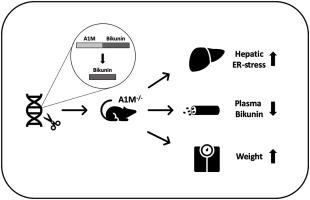Free Radical Biology and Medicine ( IF 7.4 ) Pub Date : 2020-02-21 , DOI: 10.1016/j.freeradbiomed.2020.02.019 Jesper Bergwik 1 , Amanda Kristiansson 1 , Charlotte Welinder 2 , Olga Göransson 3 , Stefan R Hansson 4 , Magnus Gram 1 , Lena Erlandsson 4 , Bo Åkerström 1

|
α1-microglobulin (A1M) is a ubiquitous protein with reductase and radical- and heme-binding properties. The protein is mainly expressed in the liver and encoded by the α1-microglobulin-bikunin precursor (AMBP) gene together with the plasma proteinase inhibitor bikunin. The AMBP polypeptide is translated, glycosylated and the C-terminal bikunin part linked via a chondroitin sulfate glycosaminoglycan chain to one or two heavy chains in the endoplasmic reticulum (ER) and Golgi compartments. After proteolytic cleavage, the A1M protein and complexed bikunin parts are secreted separately. The complete physiological role of A1M, and the reason for the co-synthesis with bikunin, are both still unknown. The aim of this work was to develop an A1M knockout (A1M−KO) mouse model lacking expression of A1M, but with a preserved bikunin expression, and to study the phenotypic traits in these mice, with a focus on hepatic endoplasmic reticulum (ER) function. The bikunin expression was increased in the A1M−KO mouse livers, while the bikunin levels in plasma were decreased, indicating a defective biosynthesis of bikunin. The A1M−KO livers also showed an increased expression of transducers of the unfolded protein response (UPR), indicating an increased ER-stress in the livers. At twelve months of age, the A1M−KO mice also displayed an increased body weight, and an increased liver weight and lipid accumulation. Moreover, the KO mice showed an increased expression of endogenous antioxidants in the liver, but not in the kidneys. Together, these results suggest a physiological role of A1M as a regulator of the intracellular redox environment and more specifically the ER folding and posttranslational modification processes, particularly in the liver.
中文翻译:

敲除小鼠体内的自由基清除剂 α1-微球蛋白会导致 bikunin 合成缺陷、内质网应激和体重增加
α 1 -微球蛋白 (A1M) 是一种普遍存在的蛋白质,具有还原酶以及自由基和血红素结合特性。该蛋白主要在肝脏中表达,由α1-微球蛋白-bikunin前体(AMBP )编码。) 基因与血浆蛋白酶抑制剂 bikunin。AMBP 多肽被翻译、糖基化并且其 C 端 bikunin 部分通过硫酸软骨素糖胺聚糖链连接至内质网 (ER) 和高尔基体区室中的一个或两个重链。蛋白水解切割后,A1M 蛋白和复合 bikunin 部分分别分泌。A1M 的完整生理作用以及与 bikunin 共合成的原因仍然未知。这项工作的目的是开发一种缺乏 A1M 表达但保留 bikunin 表达的 A1M 敲除 (A1M-KO) 小鼠模型,并研究这些小鼠的表型特征,重点是肝内质网 (ER)功能。A1M-KO 小鼠肝脏中 bikunin 的表达增加,而血浆中的bikunin水平降低,表明bikunin的生物合成有缺陷。A1M-KO 肝脏还显示未折叠蛋白反应 (UPR) 的传感器表达增加,表明肝脏中的 ER 应激增加。在 12 个月大时,A1M-KO 小鼠的体重也增加了,肝脏重量和脂质积累也增加了。此外,KO小鼠肝脏中内源性抗氧化剂的表达增加,但肾脏中没有。总之,这些结果表明 A1M 作为细胞内氧化还原环境的调节剂的生理作用,更具体地说是 ER 折叠和翻译后修饰过程,特别是在肝脏中。A1M-KO 肝脏还显示未折叠蛋白反应 (UPR) 的传感器表达增加,表明肝脏中的 ER 应激增加。在 12 个月大时,A1M-KO 小鼠的体重也增加了,肝脏重量和脂质积累也增加了。此外,KO小鼠肝脏中内源性抗氧化剂的表达增加,但肾脏中没有。总之,这些结果表明 A1M 作为细胞内氧化还原环境的调节剂的生理作用,更具体地说是 ER 折叠和翻译后修饰过程,特别是在肝脏中。A1M-KO 肝脏还显示未折叠蛋白反应 (UPR) 的传感器表达增加,表明肝脏中的 ER 应激增加。在 12 个月大时,A1M-KO 小鼠的体重也增加了,肝脏重量和脂质积累也增加了。此外,KO小鼠肝脏中内源性抗氧化剂的表达增加,但肾脏中没有。总之,这些结果表明 A1M 作为细胞内氧化还原环境的调节剂的生理作用,更具体地说是 ER 折叠和翻译后修饰过程,特别是在肝脏中。此外,KO小鼠肝脏中内源性抗氧化剂的表达增加,但肾脏中没有。总之,这些结果表明 A1M 作为细胞内氧化还原环境的调节剂的生理作用,更具体地说是 ER 折叠和翻译后修饰过程,特别是在肝脏中。此外,KO小鼠肝脏中内源性抗氧化剂的表达增加,但肾脏中没有。总之,这些结果表明 A1M 作为细胞内氧化还原环境的调节剂的生理作用,更具体地说是 ER 折叠和翻译后修饰过程,特别是在肝脏中。



























 京公网安备 11010802027423号
京公网安备 11010802027423号